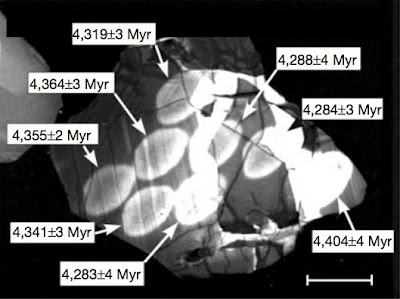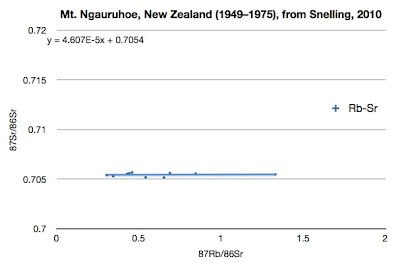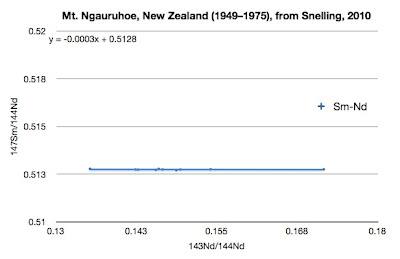Creation Science Rebuttals
Why does Andrew Snelling use RATE team funding to falsify his own claims?
© Jonathan Baker, author of the blog Questioning Answers in Genesis. This article was originally published 7 August 2012 on the Questioning Answers in Genesis blog.
I would like to suggest that if you have donated money to the Radioisotopes and the Age of The Earth (RATE) team—either directly or by supporting ICR and Answers in Genesis—then Dr. Andrew Snelling has spent that money to discredit your beliefs regarding the age of the Earth. Unfortunately, he reports this research through 'technical' articles that are unintelligible to much of his audience, and therein he hides the fact that the results actually contradict his professed beliefs. In other words, Dr. Snelling depends on the ignorance of his readers regarding geology—specifically geochronology, which entails various methods of dating rocks. Let's take a closer look, using Snelling's article on Mt. Ngauruhoe, New Zealand as an example.
Radiogenic isotope data in volcanic island arcs
If you read my previous post (The Orinoco Flow) and subsequent comments, then you are already familiar with some of the methods by which geochemists investigate tectonic processes at subduction zones (like the Lesser Antilles volcanic arc). Radiogenic isotopes (i.e. those produced by radioactive decay) are essential tools in quantifying the tectonic interplay between oceanic sediments, subducted crust, and the upper mantle—all of which contribute to magma generation that produces oceanic island chains. To date, geologists have thoroughly documented the influence of oceanic sediments—even specific river basins—on the isotope geochemistry of volcanic rocks around the world. The most relevant conclusion to this blog/discussion is that the subduction of oceanic crust was accompanied by the slow accumulation of sediment in the deep ocean over tens of millions of years. Conversely, Young-Earth models do not predict the isotopic data at volcanic island arcs, primarily because they offer no model by which the mantle and crust evolved to drastically different isotopic values.
Ratios of radiogenic isotopes can be combined with geochronological data (radiometric dates) to elucidate tectonic processes over time. The most common (and accurate) way to date such rocks is to apply the U-Pb method to zircon crystals in volcanic rocks. These crystals are quite small and rare, but are incredibly resistant to chemical alteration. In other words, geologists can use independent lines of evidence to study the history of these rocks: one isotopic system (U-Pb) to date the rocks and several others (Sr-Rb, Sm-Nd, Lu-Hf, etc.) to distinguish the origin and ascent of the magma.
As an aside, the oldest zircons to date were found in the Jack Hills of western Australia and date as old as 4,404±4 million years (see the PDF of the original article by Wilde et al., 2001). I raise that point here as a brief example of how these geochronological data look, since you can see the photos, figures, and data tables for yourself in this original Nature article. Note in particular the reproducibility of dates and the sample size (a circle ~40–50 millionths of a meter in diameter).
 |
| Figure 1b from Wilde et al. (2001), showing CL image of sampled detrital zircon. |
In his 2010 'technical' article (posted at AiG here), Andrew Snelling published the results of another RATE team project, which essentially involved sending very young volcanic rocks to geochemistry labs for a plethora of expensive analyses. Snelling believes that in the brief history of geochemistry, researchers came to discover that radiometric dates—"particularly on oceanic islands", he says—were typically unreliable and anomalously large. Consequently, he wanted to measure a handful of isotopes from volcanic rocks in New Zealand to convince his readers that radiogenic isotope ratios are quite meaningless with respect to the age of those rocks.
In actuality, Snelling's examples of 'unreliable ages' primarily derive from K-Ar determinations that were made before geochronologists knew how to correct for excess argon and xenoliths (bits of old minerals in young volcanic rocks). His stated agenda is therefore unwarranted, since more recent analyses of very young, historical volcanic rocks using the Argon-Argon technique are spot on. One example comes from the Ar-Ar dating of the 79 A.D. Pompeii eruption, which yielded an age of 1,925±94 years and is summarized in a news report here. Another comes from the re-dating of historical volcanic basalts in New Zealand using the Ar-Arg method (Cassata et al., 2008; discussed on my blog here). The work of Guillou et al. (2011), whose K-Ar, Ar-Ar and radiocarbon dates (~30,000 years) of volcanic flows and wood fragments all overlap, further corroborates my point that geologists now have little trouble obtaining reliable dates, even for very young volcanic rocks.
Before diving into a mash of petrological details, Snelling summarizes a couple of well-known geochemistry textbooks with respect to the general use of radiogenic isotopic analyses in volcanic island arcs. He writes:
This should sound familiar to you by now. It appears that Snelling generally understands that most radiogenic isotope systems in volcanic arcs are not hypothesized to reflect the age of the actual eruption. Nonetheless, Dr. Snelling continues as though geologists believe these isotopes should reflect the age of eruption and admits—albeit slyly—that he has wasted the grant money from the RATE project:
In other words, after referencing a couple of 15-25 year-old geochemistry textbooks (which all specify that Rb-Sr, Sm-Nd, and Pb-Pb isotopes in volcanic arcs are related to mixing between various mantle and crustal sources), Snelling decided to spend thousands of dollars on a handful of useless isotope data. I say 'useless' because Snelling had no meaningful hypothesis that could be tested by these data. The statement "no age information is expected" is not a scientific hypothesis. Hence, Snelling's article is by no means a 'research' paper, but rather a lab report that contains his educated opinion. In the sciences, we call this "shaking the box"—that is, to perform laboratory analyses just to see how the data will look and then describe the reasons for any trends retrospectively.
Nonetheless, even though Snelling claims that the samples were not expected to yield age information, he understands that these isotopes are radiogenic (produced by radioactive decay) and thus change over time. Dr. Snelling believes that radioactive decay occurred a million times faster within the past ~6,000 years, so within his own paradigm, these isotope ratios should reflect the passage of time somehow. Why not offer a means by which to test the young-earth model with the new isotope data? Unfortunately for Snelling, no such test exists, but with a handful of tables and verbose petrological descriptions, he is successful in misdirecting his audience.
Though he disagrees with conventional models, which say that isotope ratios of rare-earth elements in the mantle (such as Rb, Sr, Sm, and Nd) evolved through melting/recycling of crust and mantle convection, Snelling did not claim—let alone demonstrate—that his data are inconsistent with the accepted geological history of this island arc. Instead, he confuses his readers by leading them to believe that geologists typically construct Rb-Sr, Sm-Nd, and Pb-Pb isochrons and calculate Nd-model ages from continental volcanic arc samples—they don't. As in the previous example from the Lesser Antilles, geologists are interested in these isotope ratios primarily to learn about the history of subduction, composition of the mantle, and how oceanic sediments and crust are incorporated back into the mantle. For that purpose, isotopes of Sr, Rb, Sm, Nd, and Pb are extremely useful (e.g. Hart, 1988) and have been used to construct coherent models of mantle convection and mantle sources. In fact, Snelling's numerous tables and figures are perfectly consistent with the notion that volcanism in New Zealand results from the subduction of oceanic sediments on the Pacific Plate several million years ago.
No age information?
Given the dubious tactics employed by the RATE team, one should question whether Snelling's conclusion is even correct, that the isotopic data yield "no age information". Besides the brief discussion on K-Ar dates (see below), Snelling offers a strange and rather mysterious review of Rb-Sr and Sm-Nd data:
As an aside, why would a 'technical article' contain phrases like "goodness of fit statistics"? In any case, Snelling begins with an admission that he only calculated a model isochron age after cherry picking the data. Although 10 data points are available, he chooses 5—why? Apparently, Snelling wants his reader to have the impression that geochronologists arbitrarily choose their data to make the best possible fit. Of course, this is not true, but his silence on the topic leaves one to make the false assumption.
The actual (mathematical) result of cherry picking these data is an inflated margin of error (which he then complains is "intolerably large") and the option for Snelling to pretend that the isochron ages are 133 and 197 million years, respectively! When the YEC reader is told that 30-year-old volcanic flows yield isochron ages >100 million years with ridiculous margins of error, he/she is bound to believe mistakenly that Snelling's experimental data discredit radioisotope dating. Snelling makes no effort to guard against this misperception and is thus guilty of deceiving his audience. Let's take a look, rather, at how Snelling's full datasets plot:
If you are familiar at all with isochron plots (cf. Figure 5), then you already know that the flat lines imply a zero age. In other words, Snelling's isotope data did reveal age information! The age of these volcanic rocks, according to the Rb-Sr and Sm-Nd isotope systems, is consistent with the known ages of ~30–60 years. As Snelling notes, the line is statistically valid even with 5 points (MSWD < 1). The slightly non-zero slope on my plot results only from analytical uncertainty. As I mentioned, however, the isochron method is not typically employed for such systems because 1) chemical alteration can falsify the model assumptions, and 2) the U-Pb and Ar-Ar methods are far more accurate and less susceptible to and affected by chemical alteration.
Pb-Pb isochron
Snelling discusses only briefly the results of his lead-isotope data:
Sadly, this sentence is worth quoting back to any YEC that complains about being rejected by peer-reviewed journals. One cannot write a 'technical journal article' with no hypothesis and then conclude that the results 'seem' to be valid with 'some significance' without even explaining why the results (which are consistent with previously published results and interpretations) better support your interpretations.
In summary, the result of Snelling's work is twofold: 1) the isochron method works, despite Snelling's thousands-of-dollars effort to prove otherwise; and 2) the YEC worldview offers no alternative model by which to understand these data, which seem to falsify its own claims. Sr, Rb, Sm, Nd, and Pb isotopic data from Mt. Ngauruhoe, New Zealand are all consistent with a 4.5 billion-year-old Earth, which began to differentiate geochemically into various mantle domains early in its history.
K-Ar dates and "being thorough"
To add more fuel to his readers' skepticism of radioisotope methods, Snelling briefly cites his own 1998 paper, for which he obtained Potassium-Argon model ages on a ~60-year-old lava flow. These ages ranged from 0–3.5 Ma (million years). Although the laboratory was not equipped to analyze samples less than ~2 million years old or to account for xenoliths (i.e. tiny bits of material much older than the actual volcanic flow), Dr. Snelling felt convinced that "excess [Argon] had been inherited by these magmas during their genesis in the upper mantle, and therefore has no age significance."
On the contrary, these data have some "age significance"—Dr. Snelling simply declined the opportunity to interpret them scientifically. In short, he could have analyzed these samples in a modern K-Ar or Ar-Ar laboratory—the latter of which can more easily distinguish excess and inherited argon. Regardless, when margins of error and crustal contamination are taken into account, Snelling's K-Ar model ages are effectively zero for the volcanic eruption itself.
After stating that no "age information" was expected from isotopic analyses, Dr. Snelling makes another misleading and unscientific claim:
Dr. Snelling's 'thorough analysis' was unscientific because he did not define any method by which he would 'test for age information' (remember the cherry picking and disregard for complete data sets?). This statement is also misleading because his analysis was anything but thorough. For a study 'published' in 2010, whose budget was not limited, Snelling should have employed the most common precision geochronometers: the Ar-Ar and U-Th methods.
Why didn't Snelling perform these analyses?
One can only suspect that he was not interested in geological research, but a fancied petrological report (which he interprets occasionally as a consultant). The latter offers little scientific value, but allows Snelling to convince his target audience of unsupported claims—namely, that Sr, Rb, Sm, Nd, and Pb isotopes are unrelated to geological age and that geologists cannot accurately date young volcanic rocks. In summary, Dr. Andrew Snelling spent thousands of dollars—donated by AiG ministry supporters, themselves convinced of Young-Earth Creationism—on a project that only demonstrated the reliability of radiometric dating and supported conventional interpretations of radiogenic isotopes in volcanic arc systems. Snelling hid the significance of his results from the reader, however, in verbose, semi-technical writing, to which he concluded:
Snelling did not employ conventional radioisotope methods to date these rocks (Ar-Ar and U-Pb), so his first conclusion is unsupported. Nonetheless, whole-rock K-Ar ages are effectively zero, while Rb-Sr and Nd-Sm isochrons do plot on a zero-age line and so accurately reflect the absolute age of the rocks. The notion of accelerated nuclear decay—perhaps the most absurd scenario postulated by YECs—is unnecessary, therefore, to his conclusion. In any case, Snelling should explain to the reader precisely how and why accelerated nuclear decay would affect these isotope systems. The difference in isotopic ratios (e.g. 87Sr/86Sr) between the mantle and crust, for example, requires that one reservoir inherited more Rubidium than the other, after which both reservoirs underwent some ~4 billion years worth of radioactive decay. When did this happen in the Young-Earth timeline? Furthermore, according to Snelling's paradigm, why does the crust contain more Rubidium and less Samarium than the mantle? Was it simply created that way? This phenomenon is well explained by experimental geochemistry (see last post), but requires arbitrary, ad hoc assertions on the part of YECs.
I hope that by this point, you can better recognize the sly tactics of the RATE team and will pray for them to cease from taking money from hopeful supporters—all of whom are evangelical Christians that trust the judgment of AiG researchers. The RATE team results do not support the notion of a young Earth, but rather corroborate the conventional tectonic model in which the Earth evolved chemically over sever billion years. Your money is better spent tending to the widow and the orphan.
If you are not a Christian, and you have been holding out on making a decision for Christ because the Church always preached a message that was contrary to what you saw in the scientific world, then rest assured that the Bible is the inerrant Word of God, and you can believe in Christ and receive salvation, while still believing in an old earth. Click here for more.
Are you a Christian who believes in young earth creationism? Now that we have shown the many difficulties of the young earth creation science model in this and many other articles, how does this impact your Christian life? If you are a young-earth creationism believer, click here.
More Answers in Genesis Rebuttals
Leave a comment about this article on our Facebook page.
Did you know that you can be a Christian,
and believe that the earth is billions of years old? You can even
believe in evolution and be a Christian. There is no conflict
between science and the Bible...all one needs is a proper
understanding how to merge science and the Bible. To learn more
about old earth creationism, see
Old Earth Belief,
or check out the article
Can You Be A
Christian and Believe in an Old Earth?
Feel free to check out more of this website. Our goal is to
provide rebuttals to the bad science behind young earth creationism,
and honor God by properly presenting His creation.


